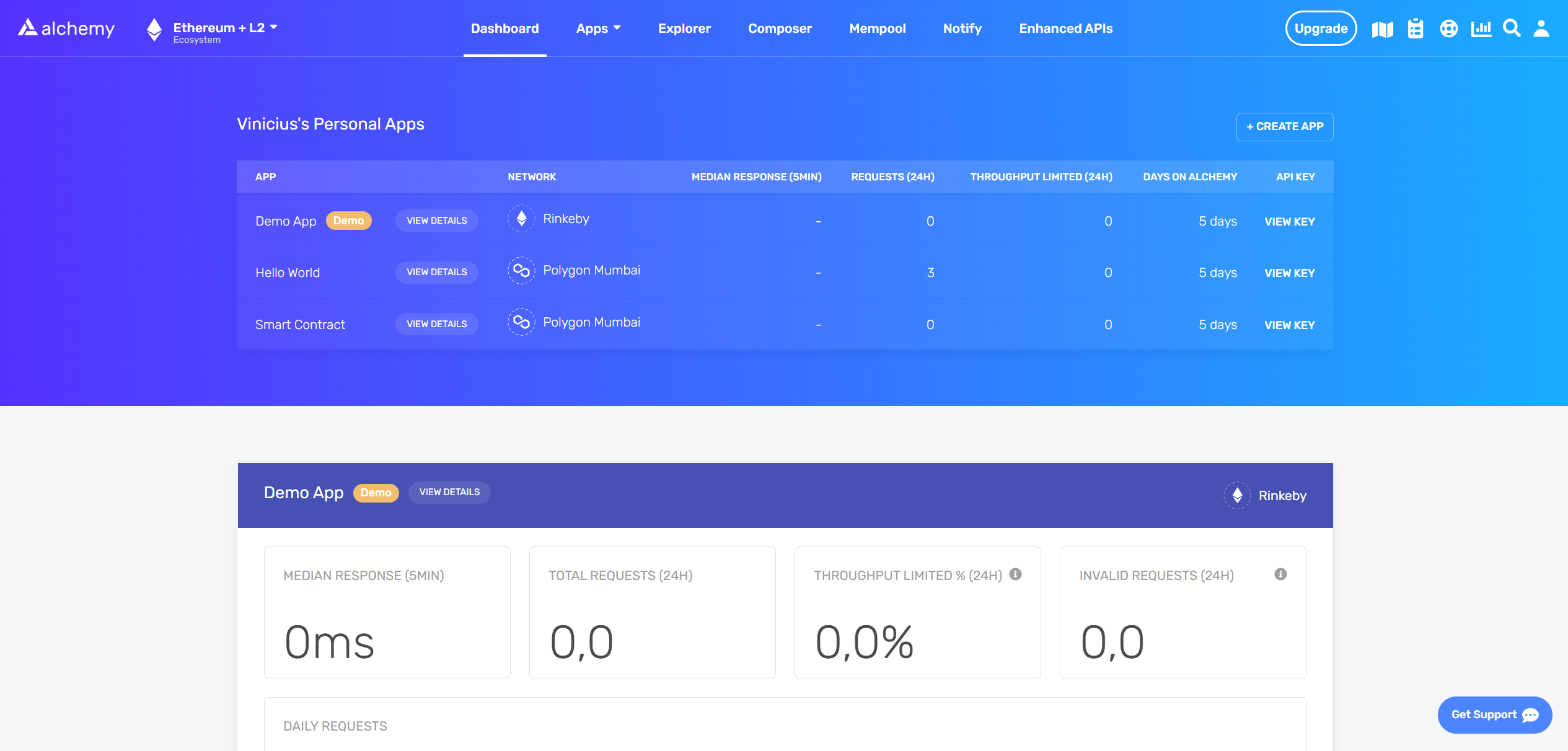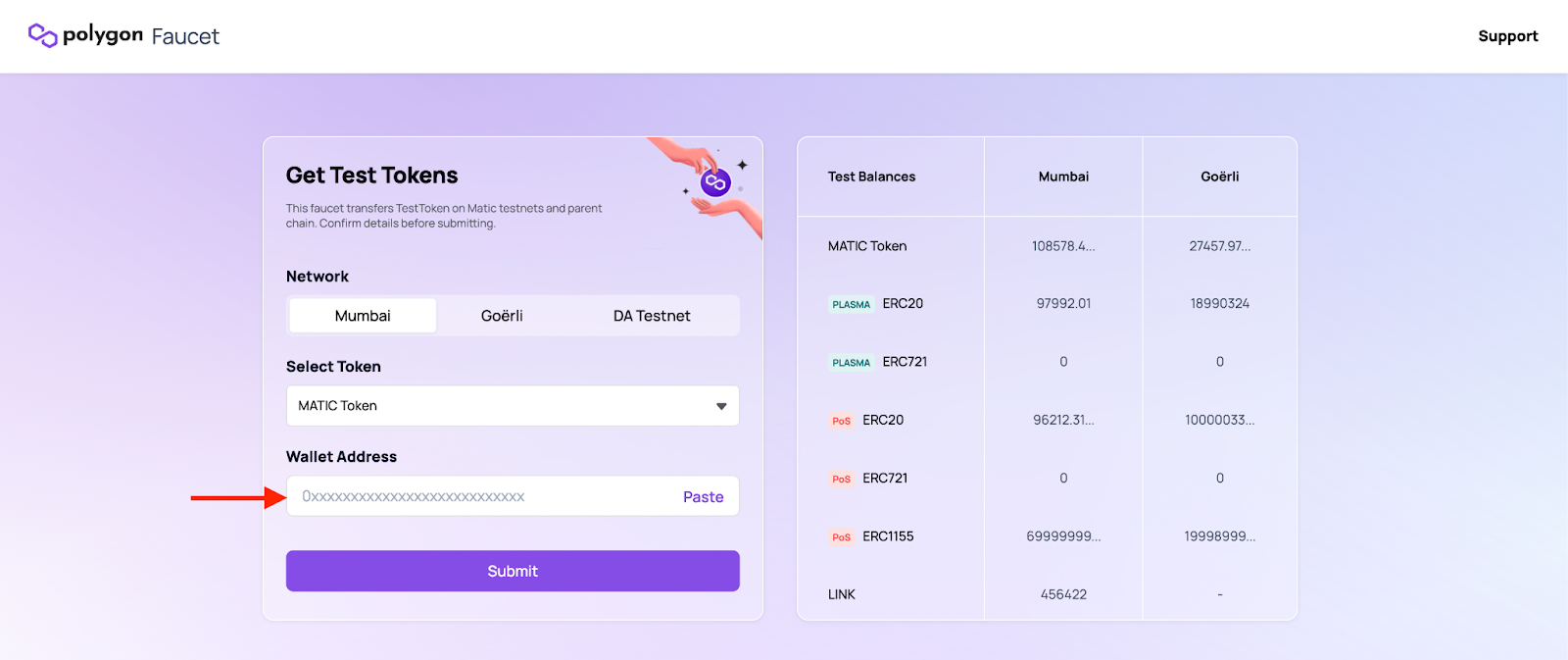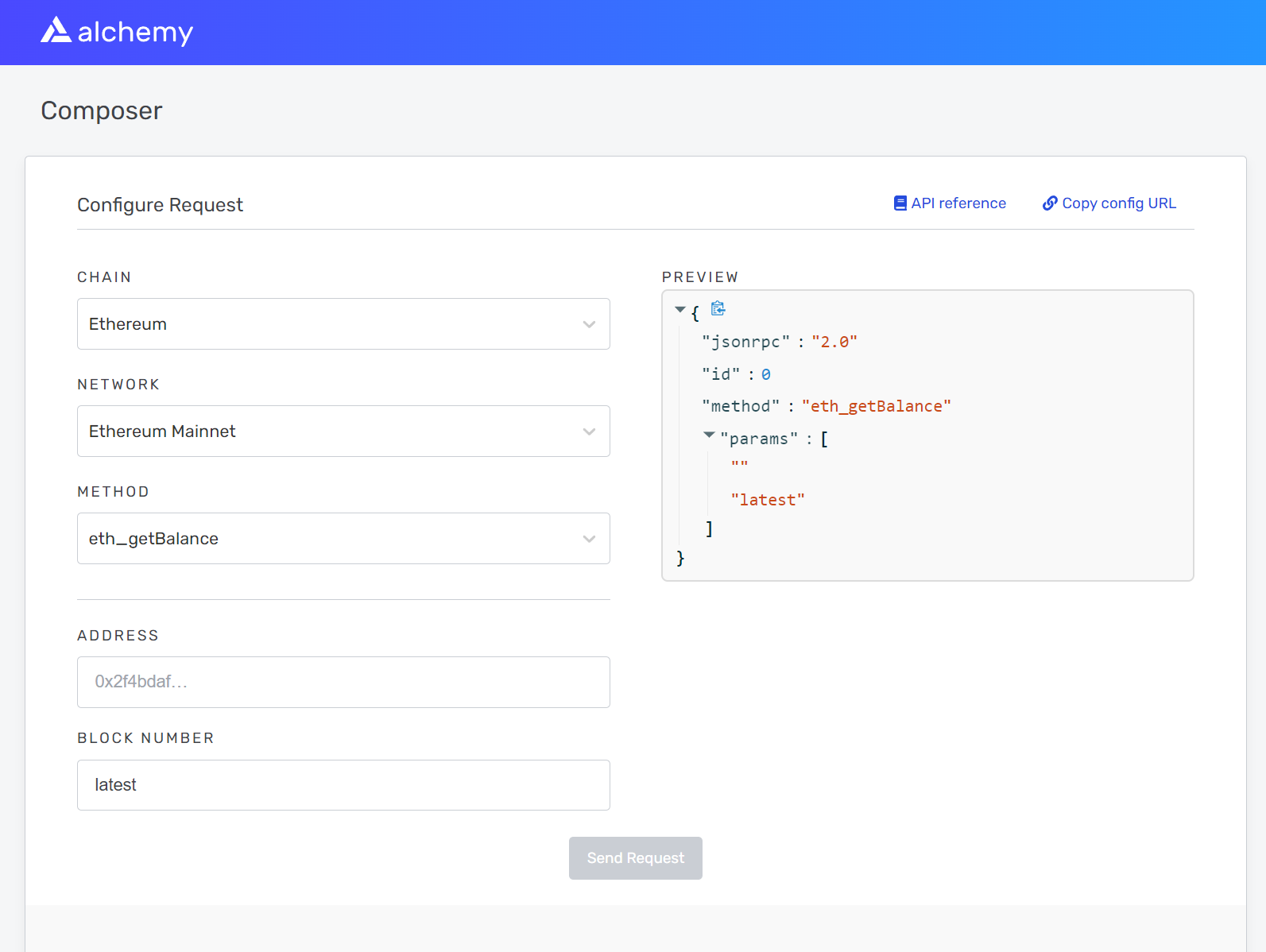Alchemy
Third-party content
Polygon technical documentation may contain third-party content, including websites, products, and services, that are provided for informational purposes only.
Polygon Labs does not endorse, warrant, or make any representations regarding the accuracy, quality, reliability, or legality of any third-party websites, products, or services. If you decide to access any third-party content, you do so entirely at your own risk and subject to the terms and conditions of use for such websites. Polygon Labs reserves the right to withdraw such references and links without notice.
Polygon technical documentation serves as an industry public good and is made available under the MIT License. In addition, please view the official Polygon Labs Terms of Use.
What you will learn¶
To create a smart contract in this tutorial, you will learn how to use Alchemy’s platform to:
- Create a smart contract application
- Check a wallet’s balance
- Verify contract calls in a blockchain explorer
What you will do¶
Following the tutorial, you will:
- Get started creating an app on Alchemy
- Create a wallet address with Metamask
- Add balance to the wallet (using test tokens)
- Use Hardhat and Ethers.js to compile and deploy the project
- Check contract status on Alchemy’s platform
Create and Deploy your Smart Contract¶
Connect to the Polygon network¶
There are several ways to make requests to the Polygon PoS chain. Rather than running your own node, you will use a free account on Alchemy’s developer platform and interact with the Alchemy Polygon PoS API to communicate with the Polygon PoS chain. The platform consists of a full suite of developer tooling – this includes the ability to monitor requests, data analytics that demonstrates what happens under the hood during smart contract deployment, enhanced APIs (Transact, NFTs, etc), and an ethers.js SDK.
If you don’t already have an Alchemy account, start by signing up for a free account here. After creating your account, you have the option of immediately creating your first app before reaching the dashboard.

Create your App (and API key)¶
After successfully creating an Alchemy account, you will need to generate an API key by creating an app. This authenticates the requests made to the Polygon Mumbai testnet. If you’re not familiar with testnets, check out this testnet guide.
To generate a new API key, navigate to the Apps tab on the Alchemy dashboard navigation bar and select the Create App sub-tab.

Name your new app Hello World, offer a short description, select Polygon for the chain, and choose Polygon Mumbai for your network.
Finally, click on Create app. Your new app should appear in the table below.
Create a Wallet address¶
Polygon PoS is a layer 2 scaling solution for Ethereum. Therefore, we need an Ethereum wallet and add a custom Polygon URL to send and receive transactions on the Polygon Mumbai testnet. For this tutorial, we will use MetaMask, a browser-compatible cryptocurrency wallet used to manage your wallet address. If you want to understand more about how transactions on Ethereum work, check out this transactions guide by the Ethereum Foundation.
To get your custom Polygon RPC URL from Alchemy, go to your Hello World app in your Alchemy dashboard and click View Key in the top right corner. Then go ahead and copy your Alchemy HTTP API key.

You can download and create a MetaMask account for free here. Once you’ve created an account, follow these steps to set up the Polygon PoS network on your wallet.
- Select Settings from the drop-down menu in the top right corner of your MetaMask wallet.
- Select Networks from the menu to the left.
- Connect your wallet to the Mumbai Testnet using the following parameters:
Network Name: Polygon Mumbai Testnet
New RPC URL: https://polygon-mumbai.g.alchemy.com/v2/your-api-key
ChainID: 80001
Symbol: MATIC
Block Explorer URL: https://mumbai.polygonscan.com/
Add Polygon Mumbai Test MATIC¶
You’ll need a few testnet tokens to deploy your smart contract to the Mumbai testnet. To obtain testnet tokens, go to the Polygon Mumbai Faucet, select Mumbai, select MATIC Token, and enter your Polygon wallet address, then click Submit. Due to network traffic, it may take some time to receive your testnet tokens.
You can also use Alchemy’s free Mumbai faucet.

You will see the testnet tokens in your MetaMask account soon after.
Check your Wallet Balance¶
To double-check our balance is there, let’s make an eth_getBalance request using Alchemy’s composer tool. Select Polygon as the chain, Polygon Mumbai as the network, eth_getBalance as the method, and input your address. This will return the amount of MATIC in our wallet. Check out this video for instructions on how to use the composer tool.

After you input your MetaMask account address and click Send Request, you should see a response that looks like this:
{ "jsonrpc": "2.0", "id": 0, "result": "0xde0b6b3a7640000" }
Info
This result is in Wei, not ETH. Wei is the smallest denomination of Ether. The conversion from Wei to Ether is: 1 Ether = 10^18 Wei. So, if we convert “0xde0b6b3a7640000” to decimal, we get 1*10^18, which equals 1 ETH. This can be mapped to 1 MATIC based on denomination.
Initialize your project¶
First, we’ll need to create a folder for our project. Navigate to your command line and type:
mkdir hello-world
cd hello-world
Now that we’re inside our project folder, we’ll use npm init to initialize the project. If you don’t already have npm installed, follow these instructions (we’ll also need Node.js so download that too!).
npm init # (or npm init --yes)
It doesn’t really matter how you answer the installation questions, here is how we did it for reference:
package name: (hello-world)
version: (1.0.0)
description: hello world smart contract
entry point: (index.js)
test command:
git repository:
keywords:
author:
license: (ISC)
About to write to /Users/.../.../.../hello-world/package.json:
{
"name": "hello-world",
"version": "1.0.0",
"description": "hello world smart contract",
"main": "index.js",
"scripts": {
"test": "echo \"Error: no test specified\" && exit 1"
},
"author": "",
"license": "ISC"
}
Approve the package.json and we’re good to go!
Download Hardhat¶
Hardhat is a development environment to compile, deploy, test, and debug your Ethereum software. It helps developers when building smart contracts and dApps locally before deploying to the live chain.
Inside our hello-world project, run:
npm install --save-dev hardhat
Check out this page for more details on installation instructions.
Create Hardhat project¶
Inside our hello-world project folder, run:
npx hardhat
You should see a welcome message and option to select what you want to do. Select create an empty hardhat.config.js:
888 888 888 888 888
888 888 888 888 888
888 888 888 888 888
8888888888 8888b. 888d888 .d88888 88888b. 8888b. 888888
888 888 "88b 888P" d88" 888 888 "88b "88b 888
888 888 .d888888 888 888 888 888 888 .d888888 888
888 888 888 888 888 Y88b 888 888 888 888 888 Y88b.
888 888 "Y888888 888 "Y88888 888 888 "Y888888 "Y888
👷 Welcome to Hardhat v2.0.11 👷
What do you want to do? …
Create a sample project
❯ Create an empty hardhat.config.js
Quit
This will generate a hardhat.config.js file for us, which is where we’ll specify all of the set up for our project.
Add project folders¶
To keep our project organized, we’ll create two new folders. Navigate to the root directory of your hello-world project in your command line and type:
mkdir contracts
mkdir scripts
contracts/is where we’ll keep our hello world smart contract code filescripts/is where we’ll keep scripts to deploy and interact with our contract
Write the contract¶
Open up the hello-world project in your favorite editor, such as VSCode. Smart contracts are written in a language called Solidity which is what we will use to write our HelloWorld.sol smart contract.
- Navigate to the
contractsfolder and create a new file calledHelloWorld.sol - Below is a sample Hello World smart contract from the Ethereum Foundation that we will be using for this tutorial. Copy and paste in the contents below into your
HelloWorld.solfile, and be sure to read the comments to understand what this contract does:
// SPDX-License-Identifier: None
// Specifies the version of Solidity, using semantic versioning.
// Learn more: https://solidity.readthedocs.io/en/v0.5.10/layout-of-source-files.html#pragma
pragma solidity >=0.8.9;
// Defines a contract named `HelloWorld`.
// A contract is a collection of functions and data (its state). Once deployed, a contract resides at a specific address on the Ethereum blockchain. Learn more: https://solidity.readthedocs.io/en/v0.5.10/structure-of-a-contract.html
contract HelloWorld {
//Emitted when update function is called
//Smart contract events are a way for your contract to communicate that something happened on the blockchain to your app front-end, which can be 'listening' for certain events and take action when they happen.
event UpdatedMessages(string oldStr, string newStr);
// Declares a state variable `message` of type `string`.
// State variables are variables whose values are permanently stored in contract storage. The keyword `public` makes variables accessible from outside a contract and creates a function that other contracts or clients can call to access the value.
string public message;
// Similar to many class-based object-oriented languages, a constructor is a special function that is only executed upon contract creation.
// Constructors are used to initialize the contract's data. Learn more:https://solidity.readthedocs.io/en/v0.5.10/contracts.html#constructors
constructor(string memory initMessage) {
// Accepts a string argument `initMessage` and sets the value into the contract's `message` storage variable).
message = initMessage;
}
// A public function that accepts a string argument and updates the `message` storage variable.
function update(string memory newMessage) public {
string memory oldMsg = message;
message = newMessage;
emit UpdatedMessages(oldMsg, newMessage);
}
}
This is a super simple smart contract that stores a message upon creation and can be updated by calling the update function.
Connect with MetaMask & Alchemy¶
We’ve created a MetaMask wallet, Alchemy account, and written our smart contract, now it’s time to connect the three.
Every transaction sent from your virtual wallet requires a signature using your unique private key. To provide our program with this permission, we can safely store our private key (and Alchemy API key) in an environment file.
First, install the dotenv package in your project directory:
npm install dotenv --save
Then, create a .env file in the root directory of our project, and add your MetaMask private key and HTTP Alchemy API URL to it.
Warning
Your environment file must be named .env or it won’t be recognized as an environment file. Do not name it process.env or .env-custom or anything else.
Also, if you are using a version control system like git to manage your project, please DO NOT track the .env file. Add .env to your .gitignore file to avoid publishing secret data.
- Follow these instructions to export your private key
- To get your Alchemy HTTP API key (RPC URL), navigate to your Hello World app on your account’s dashboard and click View Key in the top right corner.
Your .env should look like this:
API_URL = "https://polygon-mumbai.g.alchemy.com/v2/your-api-key"
PRIVATE_KEY = "your-metamask-private-key"
To actually connect these to our code, we’ll reference these variables in our hardhat.config.js file later in this tutorial.
Install Ethers.js¶
Ethers.js is a library that makes it easier to interact and make requests to Ethereum by wrapping standard JSON-RPC methods with more user-friendly methods.
Hardhat makes it easy to integrate plugins for additional tooling and extended functionality. We’ll be taking advantage of the Ethers plugin for contract deployment. Ethers.js has useful contract deployment methods.
In your project directory, type:
npm install --save-dev @nomiclabs/hardhat-ethers "ethers@^5.0.0"
We’ll also require ethers in our hardhat.config.js in the next step.
Update hardhat.config.js¶
We’ve added several dependencies and plugins so far. Now we need to update hardhat.config.js so that our project recognizes those dependencies.
Update your hardhat.config.js to look like this:
/**
* @type import('hardhat/config').HardhatUserConfig
*/
require('dotenv').config();
require("@nomiclabs/hardhat-ethers");
const { API_URL, PRIVATE_KEY } = process.env;
module.exports = {
solidity: "0.8.9",
defaultNetwork: "polygon_mumbai",
networks: {
hardhat: {},
polygon_mumbai: {
url: API_URL,
accounts: [`0x${PRIVATE_KEY}`]
}
},
}
Compile our Smart Contract¶
To make sure everything is working so far, let’s compile our contract. The compile task is one of the built-in hardhat tasks.
From the command line run:
npx hardhat compile
You might get a warning about SPDX license identifier not provided in source file , but the application might still be working fine. If not, you can always message in the Alchemy discord.
Write our deploy script¶
Now that our contract is written and our configuration file is good to go, it’s time to write our contract deploy script.
Navigate to the scripts/ folder and create a new file called deploy.js, adding the following contents to it:
async function main() {
const HelloWorld = await ethers.getContractFactory("HelloWorld");
// Start deployment, returning a promise that resolves to a contract object
const hello_world = await HelloWorld.deploy("Hello World!");
console.log("Contract deployed to address:", hello_world.address);
}
main()
.then(() => process.exit(0))
.catch(error => {
console.error(error);
process.exit(1);
});
We’ve adopted the Hardhat team explanations to what each of these lines of code does from their Contracts tutorial here.
const HelloWorld = await ethers.getContractFactory("HelloWorld");
A ContractFactory in ethers.js is an abstraction used to deploy new smart contracts, so HelloWorld here is a factory for instances of our hello world contract. When using the hardhat-ethers plugin ContractFactory and Contract, instances are connected to the first signer (owner) by default.
const hello_world = await HelloWorld.deploy();
Calling deploy() on a ContractFactory will start the deployment, and return a Promise that resolves to a Contract object. This is the object that has a method for each of our smart contract functions.
Deploy our Smart Contract¶
Navigate to the command line and run:
npx hardhat run scripts/deploy.js --network polygon_mumbai
You should see something like this:
Contract deployed to address: 0x3d94af870ED272Cd5370e4135F9B2Bd0e311d65D
If we go to the Polygon Mumbai explorer and search for our contract address, we should be able to see that it has been deployed successfully.
The From address should match your MetaMask account address and the To address will say Contract Creation. But if we click into the transaction, we’ll see our contract address in the To field.

Verify the Contract¶
Alchemy provides an explorer where you can find information about the methods deployed along with the smart contract, such as response time, HTTP status, error codes among others. It is a good environment to verify your contract and check whether the transactions went through.

Congratulations! You just deployed a smart contract to the Polygon Mumbai network.
Additional Resources¶
- How to Develop an NFT Smart Contract – Alchemy has a written tutorial with a Youtube video on this topic. This is week 1 of its free 10 week Road to Web3 dev series
- Polygon API Quickstart – Alchemy’s developer docs guide to getting up and running with Polygon